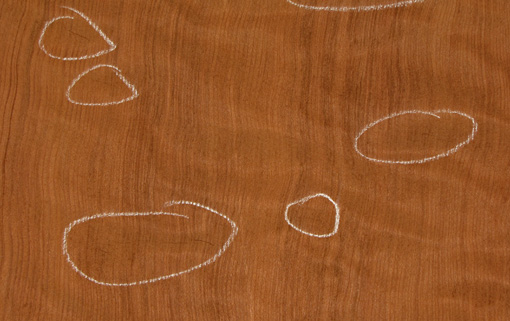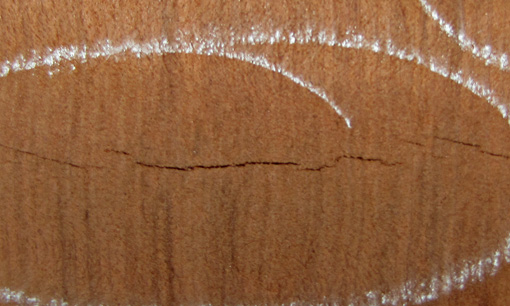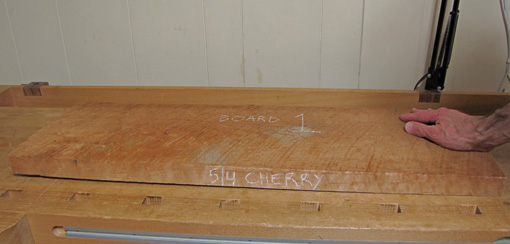
When I design a piece, thoughts of the wood come early in the process. Sometimes, the inspiration from very special wood creates the energy to initiate a project. The form and the wood work hand-in-hand as nature’s gift of wood animates the design.
Yet nature can be cruel. Over the years, despite my continuous effort to learn more about and experience more wood, I have run into disappointments. Sure, I am careful picking boards at the local yard or consulting on purchases from afar, but sometimes the eye, judgement, or just plain luck fails in the quest for wood. It is wood, after all, and we have to take the good with the bad. Here is some of the bad.
The top photo shows compression failures in an otherwise great slab of figured redwood. These are thin, irregular fatal compromises in the cell structure of the wood across the grain. They lurk invisibly on the rough-sawn surface only to reveal themselves after planing. They may occur when the tree is felled or from severe weather stress. I have also seen them in bubinga and mahogany, both large trees.
Below is a close-up photo of another compression failure in the same board, showing a characteristic wrinkly cross-grain split.


Notice the raised left side of the 5/4 cherry, above. It is easy for twist to go unnoticed in the commotion of the lumber yard. The full width of this board would probably be less than 3/4″ thick after dressing because the twist must be removed from both faces. To retain more thickness, this piece can be ripped into narrower sections – safely on the bandsaw not the table saw.
Similarly, thickness can disappear in surprising amounts when flattening a long bowed board or a wide cupped board. More commonly than any other problem, failure to retain the desired thickness, width, and length while removing distortion has destroyed my plans for wood parts.
A distortion that I stay away from is crook, which is fortunately easy to see – the board looks like a level road with a curve. Crook is a tip-off to the presence of reaction wood which is produced by tree trunks that lean. The pith is typically decentered which makes the widths of the growth rings markedly different on each side of a flatsawn board. These boards can unpredictably shrink along the grain and distort oddly. They are incorrigible miscreants that belong in wood hell, also known as the fireplace. Severely twisted boards should also be rejected because they certainly harbor some weirdness, with which you do not want to deal, that made them twist in the first place.
Sometimes, the wood and the woodworker just don’t get along. With great anticipation, I once started working with some beautiful curly makore. Within hours my nose and throat were scratchy and I felt strangely unsettled. Assuming that I was allergic or otherwise sensitive to this species, I decided to avoid unnecessary risk and get this wood out of the shop.
I’m afraid there’s more disappointments coming up in the next post.


Rob
Yes working with wood can at times be frustrating, but the pleasure overrides these frustrations. I aim for excellence, and am learning that perfection is not really possible, so I accept those imperfections such as compression failures that nature throughs at us.
I think it is more humankind that is cruel, by not utilising the resources provided by nature responsibly and sustainably, resources are now becoming scarcer and more expensive so we are being forced into accepting that the ” perfect ” wood is realistically not available. I ( like most ) prefer to work in solid wood, partly as my upbringing included viewing veneered work as inferior and a substitute for ” real wood “. Now I aim to use every piece of wood that I bring into the workshop, use the really fine wood for face veneers in laminated work, so that other lesser wood, free of major defects can be used in the core of components or on the non show side of a piece.
Reading this it sounds a bit like a criticism of you, and I should say that it is not intended that way, it is simply my point of view.
Thank you for spending time on your website
Regards From Australia
Ah; that’s what those lines are. I had a piece of paduak with that sort of thing going on. Not knowing any better, I made a guitar neck out of it anyway; (things didn’t show up until I was well into the carving) I guess I lucked out in that over the years it has been one of my more stable attempts at that sort of thing.
David,
Thanks for the thoughtful comment.
j.p.,
Yea, sometimes luck is what we need.
Rob
Rob – is there any way you can post a higher resolution pic of that compression failure? I’ve never heard of it and I have a hard time picturing it/making it out.
Aaron,
I added a close-up photo. They can be tough to see on actual wood too!
Rob
thanks for the update, rob. I seem to remember a little of that going on in some very old reclaimed mahogany I have… I thought it was because of its age and previous incarnation as trim/baseboard molding.
will this generally happen in isolated spots or in a cluster the way you’ve shown it?
Aaron,
The board shown in the post was a disaster case and was full of them, which as far as I know is unusual. I have seen just a couple in an otherwise fully sound bubinga plank. An experienced lumberman would know more.
Rob
When I went in and was checked for allergies, they found I was allergic to 4 different types of wood. Working with those types have not caused me much trouble, but I try to avoid burning them in my shops wood stove.